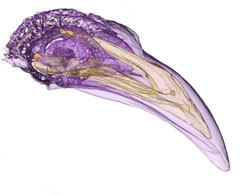Magnetic navigation – putting the cat among the pigeons

A high resolution MRI (magnetic resonance image) of the pigeon beak, showing the area in which the IMP-team searched for magnetic neurons, but instead found iron-rich macrophages. Copyright: Johannes Riegler, UCL<br>
However, research published today in Nature shows that this is not the case. The study shows that iron-rich cells in the pigeon beak are in fact specialised white blood cells, called macrophages. This finding, which shatters the established dogma, puts the field back on course as the search for magnetic cells continues.
“The mystery of how animals detect magnetic fields, has just got more mysterious” said Dr David Keays who led the study. Dr Keays’s lab, based at the Research Institute of Molecular Patholgy (IMP) in Vienna, worked together with Dr Shaw from the University of Western Australian and Dr Mark Lythgoe from the UCL Centre for Advanced Biomedical Imaging. Together they employed state-of-the-art imaging techniques to visualise and map the location of iron rich cells in the pigeon beak.
“We had hoped to find nerves with magnetic crystals” said Dr Keays “but unexpectedly we found thousands of macrophages, each filled with tiny balls of iron.” Macrophages are a type of white blood cell that play a vital role in defending against infection and re-cycling iron from red blood cells, “but they’re unlikely to be involved in magnetic sensing“ explained Dr Keays.
The search for the actual mechanism that allows migratory birds, and many other animals, to respond to the Earth's magnetic field and navigate around their environment remains an intriguing puzzle to be solved.
“We have no idea how big the puzzle is or what the picture looks like, but today we’ve been able to remove those pieces that just didn’t fit“ said Dr Keays.
Media Contact
More Information:
http://www.imp.ac.atAll latest news from the category: Life Sciences and Chemistry
Articles and reports from the Life Sciences and chemistry area deal with applied and basic research into modern biology, chemistry and human medicine.
Valuable information can be found on a range of life sciences fields including bacteriology, biochemistry, bionics, bioinformatics, biophysics, biotechnology, genetics, geobotany, human biology, marine biology, microbiology, molecular biology, cellular biology, zoology, bioinorganic chemistry, microchemistry and environmental chemistry.
Newest articles

Bringing bio-inspired robots to life
Nebraska researcher Eric Markvicka gets NSF CAREER Award to pursue manufacture of novel materials for soft robotics and stretchable electronics. Engineers are increasingly eager to develop robots that mimic the…

Bella moths use poison to attract mates
Scientists are closer to finding out how. Pyrrolizidine alkaloids are as bitter and toxic as they are hard to pronounce. They’re produced by several different types of plants and are…

AI tool creates ‘synthetic’ images of cells
…for enhanced microscopy analysis. Observing individual cells through microscopes can reveal a range of important cell biological phenomena that frequently play a role in human diseases, but the process of…





















